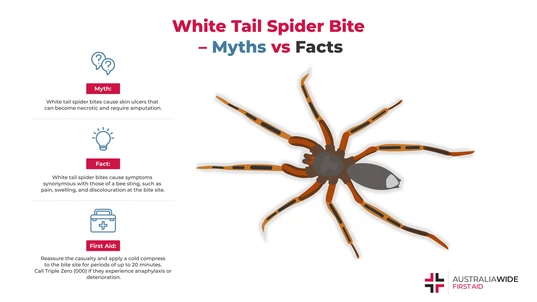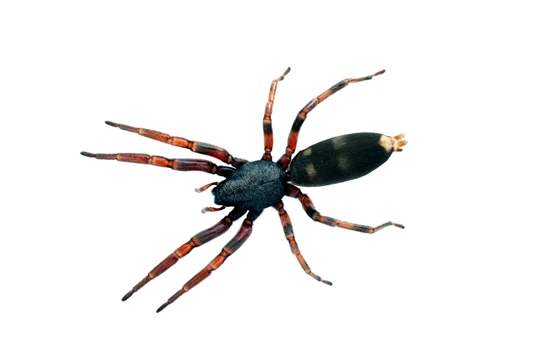White Tail Spider Bite: Separating Myth from Fact

Bites and Stings

White tail spiders are common in Australian households, as they enjoy hiding between pieces of fabric and in cool, tiled areas. White tail spider bites have long been associated with extreme inflammation and skin loss.
For many years, necrotic skin ulcers have been linked to white tail spider bites, leading to a fear in the general population about white tail spiders. People claim that white tail spiders can be ‘flesh-eating’ spiders, whose bites lead to open wounds that never heal, and even body parts that need to be amputated. White tail spiders were given a bad reputation, likely because they are a common household spider and therefore a spider that people interact with a lot. However, recent findings have shown otherwise. These studies indicate that white tail spiders are actually not to blame for the necrotic arachnidism (extreme inflammation and skin loss) people are so afraid of. Although white tail spider bites may cause discomfort such as inflammation and pain, they are often not as dangerous as they are so commonly perceived to be and are certainly not cause for panic. Many white tail spider bites can be treated at home and symptoms will subside in a relatively short period of time. For more information about how to provide first aid for a White tail spider bite, watch the short video below:White Tail Spider Bites and Necrotic Arachnidism
For quite a while, white tail spider bites have been closely associated with a phenomenon called ‘Necrotic Arachnidism’ . This phenomenon refers to ulceration and inflammation that has been claimed to result from a spider bite, which is ghastly in appearance and certainly something that anyone with skin should be fearful of. In some severe cases, necrotic arachnidism can result in excessive skin loss. Although necrotic arachnidism does exist, it is primarily a result of bacterial infection, not a white tail spider bite as many people believe. A study in 2003 proved that white tail spider bites are not actually as harmful as their reputation suggests. In 130 Australian patients who reported having white tail spider bites, none of them had skin ulcers which directly contradicts the claims that white tail spider bites cause this skin condition. Necrotic ulcers themselves can be a result of bacterial infections, but according to recent studies, they are not directly related to white tail spider bites as so many people believe.Symptoms of a White Tail Spider Bite
The surest way to identify a white tail spider bite is to capture the spider that bit you if possible. This way, doctors can be sure of the type of spider bite that you have and can treat the bite accordingly. This must be done very carefully, however, to ensure that you and no one else in your household do not receive another bite from the spider. If you are brave enough to attempt to catch the spider, do so with a container that has a lid. Turn over the container, and trap the spider by enclosing the container over the spider. The container should make an enclosed dome over the spider. Next, find a sturdy flat surface, like a piece of cardboard, to carefully slide under the opening at the bottom of the container. This will take some shimmying and adjusting of the container to get the cardboard underneath it while also keeping the opening sealed. Do so with caution. Now, while holding the cardboard tightly, slowly turn the container upward so the cardboard and the top of the opening is toward the sky. Next, quickly and carefully remove the cardboard and replace the opening with a cover such as a tightly sealed lid or a screw on cover. Again, you will want to manoeuvre this without ever leaving an opening that the spider could crawl out of at the top. If you are not so brave as to go on this spider catching escapade, identifying the spider by size, colour, and where the spider was found can also be helpful information in treating the bite. The more information you are able to provide, the easier it will be for the doctor to treat the bite properly. If you are not able to capture the spider, there are some other ways to know if your bite could be a white tail spider bite. At the point of contact, there would likely be a red mark that seems irritated, is swelling, itching, and uncomfortable. The duration of these symptoms can last 24 hours or can last for a week depending on the bite. In rarer cases, these bites can lead to severe pain, headaches, sickness, nausea, and vomiting. Of course, if you have any of the severe symptoms above, you will need to seek medical attention.Distribution and Habitat
Across Australia, there are about 2000 spider species in total. White tail spiders are found primarily across southern Australia and eastern Australia. A household white tail spider can be found in bedding, shoes, items on the floor, and cool and tiled areas. A white tail spider is a common spider found in the household; however, their ideal meal is never human skin - a white tail spider’s preferred prey is actually other spiders. So although your favourite household company may not include a white tail spider, they are doing their chores by taking care of the other spiders so that you do not have to!Looking to get you First Aid knowledge up to date?
We run certified First Aid courses throughout all major Acustralian citys. Find a location near you.

White tail spiders are renowned for having a white spot at the tip of their dorsal abdomen. Another distinctive feature is their cylindrical, cigar-shaped body, which tends to be grey to dark reddish in colour.
Appearance
The body of the white tail spider is cylindrical and shaped like a cigar. It is also grey to dark reddish in colour. Unsurprisingly, white tail spiders are easily identifiable by a white spot at the tip of their abdomen. Grey white tail spiders may also have two pairs of faint white spots on the top of their dorsal abdomen. However, these tend to be less distinct in adults. Their legs can span up to 5 cm in length and tend to be covered in orange-brown bands.First Aid for a White Tail Spider Bite
As with all spider bites, it's important to know first aid for a white tail spider bite:- Reassure the casualty and keep them under constant observation.
- Apply a cold compress to the bite site for periods of up to 20 minutes to lessen the pain.
- If the casualty is a young child (under 8 years), a pregnant woman, or if they exhibit any signs of deterioration, follow the basic life support guidelines per DRSABCD and call Triple Zero (000) for an ambulance.
- DO NOT use the Pressure Immobilisation Technique, as the venom moves slowly and this will just worsen the pain.
White Tail Spider Bite and Anaphylaxis
Some people can have a severe allergic reaction when bitten by a white tail spider. This is called anaphylaxis, a condition that can be fatal in as little as 15 minutes. Symptoms include:- Tightness of the throat from swelling.
- Difficulty breathing.
- Tongue and facial swelling.
- Hoarse voice or difficulty speaking.
- A wheeze or persistent cough.
- Collapse or falling unconscious.
- Becoming pale or floppy (young children).
- Abdominal pain and vomiting.
- Hives, welts, and body redness.
Final Thoughts
Although white tail spider bites are often feared due to their common appearances in households, they are not nearly as threatening as many people believe. Necrotic arachnidism is not actually linked to white tail spider bites according to recent studies. Although white tail spider bites will result in some temporary discomfort, they are likely not so severe that they need to be treated by a medical professional. The more information that you can give to doctors about the type of spider that bit you, the better for their plan of treatment. If you would like to know more about identifying and treating white tail spider bites, our First Aid course with Australia Wide First Aid is a wonderful place to get informed on these bites, and to learn how to care for someone who has a white tail spider bite.
Originally published at
https://www.australiawidefirstaid.com.au/resources/white-tail-spider-bite
as part of the Australia Wide First Aid Articles Library









